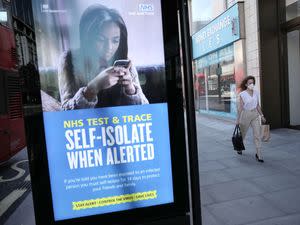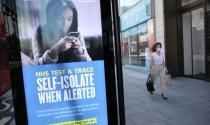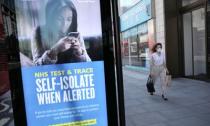Coronavirus: Weekly COVID-19 cases up 61% in England, Test and Trace figures show
More than 31,000 people were found to have the coronavirus in England between 17 September and 23 September - the highest weekly number since Test and Trace was launched at the end of May.
"Positive cases have been rising steeply over the last four weeks with over four times as many positive cases identified in the most recent week compared to the end of August," Test and Trace said on Thursday.
The positivity rate is at 5.28% - the highest since the scheme began and the first time it has exceeded 5%.
The UN World Health Organisation said for the virus to be under control the proportions of tests giving a positive result should be less than 5%.
The figures contradict findings from Imperial College London which suggested the virus may be slowing.
Research by Imperial College London and Ipsos Mori showed the R number, a key indicator which shows the virus reproduction rate, fell from 1.7 to 1.1 since the beginning of the month.
Prime Minister Boris Johnson has implored Britons to follow rules introduced in a bid to stem a rise in COVID-19 cases and avert a second lockdown.
At a news conference on Wednesday the PM's scientific advisors warned the virus is starting to get out of control.
Sir Patrick Vallance said: "we don't have this under control at the moment".
"This is headed in the wrong direction, there is no cause for complacency."
The figures from Test and Trace show the system is still failing to reach 80% of the close contacts identified by those testing positive.
This is the benchmark the PM's scientific advisers said would need to be reached to stop the virus spreading.
According to the latest stats some 71.6% of close contacts of people who tested positive for COVID-19 in England were identified in the week ending September 23.
This is down from 76.3% in the previous week, but above the 69.9% for the week to September 2, which is the lowest weekly figure to date.
For cases handled by local health protection teams, 97.6% of contacts were reached and asked to self-isolate and for those handled online or by call centres 64.3% were reached.
Furthermore, three in 10 people testing positive for COVID-19 and identified by NHS Test and Trace could not be contacted, the data shows.
Between September 17 and 23, 71.3% were reached and asked to provide information about their contacts.
This is a 10% drop from 80.8% in the previous week.
Shadow health minister, Justin Madders, said: "For the proportion of people being contacted to drop by nearly 10% in a week is appalling. It should not be happening at this point."
There has been a rise in the proportion of people who have an "in-person" test getting their result within 24 hours.
The data shows that 38.1% of people at a regional site, local site or mobile testing unit - a so-called "in-person" test - received their result within this timeframe.
This is up from 28.2% in the previous week and follows weeks of problems with people accessing tests.
Although it is down from the week ending 1 July, when 94.3% of in-person test results were returned in 24 hours - the best the service has performed.
Mr Johnson had pledged that, by the end of June, the results of all in-person tests would be back within 24 hours.
Just 2.9% of people in England who used a home test kit for COVID-19 received their result within 24 hours in the week to September 23.
This is up slightly from 1.8% in the previous week, which was the lowest weekly percentage since Test and Trace began.
Some 30.4% of people received the result of a home test within 48 hours, up from 11.3% in the previous week.
The government said testing capacity was increasing and the median distance travelled by people who go for a test is now 4.3 miles, down from 5.2 miles the previous week.
Baroness Dido Harding, interim executive chairwoman of the National Institute for Health Protection, said: "One in eight people in England have now received a test at least once and with nearly 500 testing sites across the UK, the median distance to a test site is now just 4.3 miles."
She said a partnership with Birmingham University is "another example of how the public, private and academic sectors are working together to meet our target of 500,000 test capacity a day".
"In the meantime, NHS Test and Trace has now reached more than half a million people and advised them to self-isolate," she said.
"In the past week more than 14 million people have downloaded the new Covid-19 app, all of which will help break the chains of transmission."
Analysis: We're still seeing a rise - just when we might have expected a fall
By Rowland Manthorpe, technology correspondent
This morning a big study from Imperial suggested that the outbreak was reducing in the UK. Today's Test and Trace statistics tell a different story.
It's not just that 31,373 new people tested positive, a rise of 61% on the previous week, it's that they did so without a jump in the number of tests.
One frequently-asked question is whether more tests means more cases.
Most of the time, it does - but it's easy to make sure you're not being influenced by that by working out what fraction of tests are positive, a number known as the positivity rate.
This week, the positivity rate jumped from 3.2% to 5.3, the highest rate since Test and Trace began. This is potentially a crucial milestone as the WHO has said for the virus to be under control the proportions of tests giving a positive result should be less than 5%.
As always, this number comes with a big caveat: the data is extremely noisy and the Department of Health cautions against using it in this way, as it says the way the data is presented makes it impossible.
But even if it only gives a trend, rather than a whole-population figure, we're still seeing a rise, just when we might have expected a fall.

 Yahoo News
Yahoo News 










